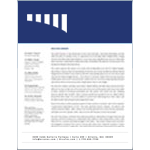
U.S. Economic News
February 19, 2020
U.S. Economic Indicators
Privately-owned housing starts fell 3.6% in January to a seasonally adjusted annual rate of 1.57 million (up 21% year-over-year). Housing permits rose 9.2% to a 1.55 million annual pace in January (up 18% from last year). Census Bureau Report
The headline Producer Price Index (“PPI”) for final demand rose 0.5% in January and is up 2.1% year-over-year. The core — which removes the volatile prices of food, energy, and trade services —rose 0.4% in January and is up 1.5% from a year ago. BLS Report
U.S. News
Bloomberg reports that the International Monetary Fund has reiterated that global economic growth is likely to strengthen somewhat in 2020, despite downside risks from the Wuhan coronavirus and trade tensions. The IMF left its January projection for global growth unchanged, projecting an acceleration to 3.3% growth this year from a 2.9% pace in 2019. Bloomberg